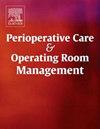Employing lean six sigma strategies to improve operating room first case on-time starts: A case report
IF 1
Q2 Nursing
Perioperative Care and Operating Room Management
Pub Date : 2025-01-16
DOI:10.1016/j.pcorm.2025.100473
引用次数: 0
Abstract
Background
The operating room is a key driver of hospital revenue, making the monitoring of performance metrics crucial for cost reduction. Perioperative leaders often struggle to pinpoint the causes of delays. This article describes how an ambulatory surgical center implemented Lean Six Sigma methodology to identify barriers and implement targeted interventions to improve first-case on-time starts.
Methods
A multidisciplinary committee employed the standard process improvement methodology known as define-measure-analyze-improve-control (DMAIC) to assess workflow, identify the root causes of delays, and implement five targeted interventions to improve workflow.
Results
Data from 888 cases were examined over a 20-month period in the perioperative department, 180 cases before and 708 cases during and after implementation. First case on-time starts increased from 30 % to 79 % 12 months after the interventions were implemented. Additionally, delays in OR minutes decreased by approximately 49 % during this time frame.
Conclusion
A multidisciplinary committee's use of Lean Six Sigma strategies, particularly the DMAIC framework, has effectively identified barriers to on-time first case starts in the OR. This approach established a solid foundation for developing targeted problem-solving interventions. By applying this methodology, the committee improved operational efficiency and reduced delays in the surgical workflow.
运用精益六西格玛策略提高手术室首个病例准时启动:一个案例报告
手术室是医院收入的主要驱动因素,因此监控绩效指标对于降低成本至关重要。围手术期的领导往往难以确定延误的原因。本文描述了门诊外科中心如何实施精益六西格玛方法来识别障碍并实施有针对性的干预措施,以提高首次病例的准时开始。方法一个多学科委员会采用标准的流程改进方法,即定义-测量-分析-改进-控制(DMAIC)来评估工作流程,确定延误的根本原因,并实施五项有针对性的干预措施来改善工作流程。结果共收集围手术期资料888例,实施前180例,实施中及实施后708例。在实施干预措施12个月后,首次病例准时开始治疗的比例从30%增加到79%。此外,在这段时间内,延迟时间减少了大约49%。多学科委员会使用精益六西格玛策略,特别是DMAIC框架,有效地确定了手术室首次病例按时开始的障碍。这种方法为制定有针对性的解决问题的干预措施奠定了坚实的基础。通过应用这种方法,委员会提高了操作效率,减少了手术工作流程的延误。
本文章由计算机程序翻译,如有差异,请以英文原文为准。
求助全文
约1分钟内获得全文
求助全文
来源期刊

Perioperative Care and Operating Room Management
Nursing-Medical and Surgical Nursing
CiteScore
1.30
自引率
0.00%
发文量
52
审稿时长
56 days
期刊介绍:
The objective of this new online journal is to serve as a multidisciplinary, peer-reviewed source of information related to the administrative, economic, operational, safety, and quality aspects of the ambulatory and in-patient operating room and interventional procedural processes. The journal will provide high-quality information and research findings on operational and system-based approaches to ensure safe, coordinated, and high-value periprocedural care. With the current focus on value in health care it is essential that there is a venue for researchers to publish articles on quality improvement process initiatives, process flow modeling, information management, efficient design, cost improvement, use of novel technologies, and management.
 求助内容:
求助内容: 应助结果提醒方式:
应助结果提醒方式:


